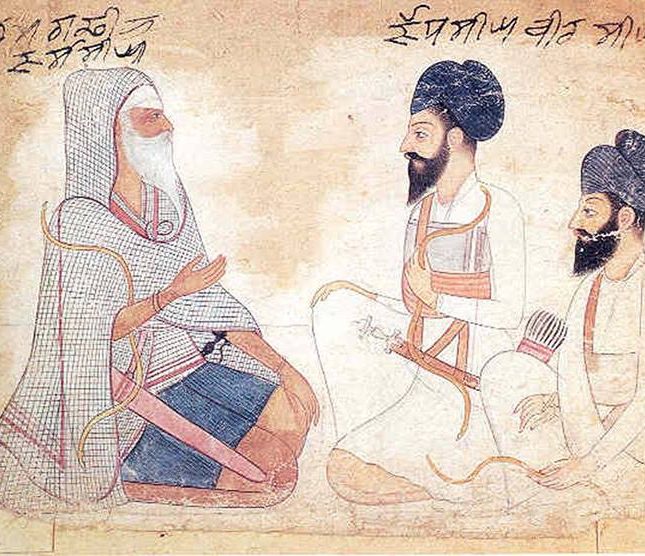HARIJAS GRANTH, by Bhai Darbari, is a collection of verse, the first part (ff. 1–530) of which is, in imitation of the Guru Granth Sahib, cast in rdgas, totalling thirty-four in number—adding Malkauns, Malva, and Hindol to the thirty-one employed in the Sikh Scripture. The only known manuscript of the Harijas Granth, comprising 918 folios, which has so far remained unpublished and which was, according to internal evidence (f. 760), completed on Thursday, Jeth Vadi 13, 1860 Bk/20 May 1803, is preserved in the Gurdwara Bhai Darbari at the village of Vairoke in Faridkot district. Bhai Darbari was a follower of Bhai Abhai Ram, who was fifth in the line from Baba Miharban, leader of the schismatic Mina group of the Sikhs, and who later received the rites of Sikh baptism at the hands of Guru Gobind Singh and came to be known as Abhai Singh. The Harijas Granth begins with the Sikh Mul Mantra, here recorded in a somewhat changed order.
Then follows a hymn attributed to Mahala 7 or Nanak VII which here stands for Hariji. Then there is a sloka by Bhai Darbari in which he pays laudation to God and then to the first five Gurus, thereafter praising the Minas who had broken away from the main Sikh tradition and set up a separate sect. The first major composition, untitled, imitates Guru Nanak’s Japu(ji) and comprises, like the latter, 38 stanzas. Whereas the first part (ff. 1–530) of the Granth contains hymns in different metres, forms, and rdgas, the latter part (ff. 531–918) is not set in any rdga and is titled Parchidin Bhagatdin Kidan, containing accounts of thirty saints such as Dhru, Prahlad, Janak, Sita, Draupadi, Arjun, Udho, Ramanand, Jaidev, Namdev, Trilochan, Kabir, Ravidas, Sadhna, Sain, Pipa, and Sur Das.
The Granth represents an amalgam of Sikh and Hindu tenets. Some of a total of twenty verses in the first part of the Granth are entirely devoted to eulogizing the various incarnations of God accepted in Hinduism. The author has stressed the transience of this world and impressed on man the need to be detached. Crucial is the role of the Guru in helping man in his spiritual pursuit. The language of the Granth is a mixture of Punjabi and Sadh Bhakha; the script is Gurmukhi.
Overview and Historical Context
Harijas Granth is a fascinating yet unpublished manuscript composed by Bhai Darbari. This work is a collection of verse that, in many ways, mirrors the stylistic and spiritual ambience of the Guru Granth Sahib. Its composition is notable for the deliberate imitation of the sacred text’s use of rdgas (metrical patterns)—the Harijas Granth employs thirty‐four rdgas compared to the thirty‐one traditionally employed in the Guru Granth Sahib. According to internal evidence (folio 760), the manuscript was completed on Thursday, Jeth Vadi 13, 1860 Bk (20 May 1803). Today, the only known manuscript—comprising 918 folios—is carefully preserved in the Gurdwara Bhai Darbari at the village of Vairoke in Faridkot district .
Structure and Literary Composition
The work is structured in two major parts with clear distinctions in style and content:
- First Part (ff. 1–530):
In imitation of the Guru Granth Sahib, the opening section of the Harijas Granth begins with the Sikh Mul Mantra, albeit recorded in a somewhat altered order. Soon after, a hymn attributed to Mahala 7 (or Nanak VII, serving as a stand-in for Hariji) is presented. This early portion also includes a laudatory sloka in which Bhai Darbari extols God and the first five Gurus. Following these initial invocations, the text features a major untitled composition that mimics the format of Guru Nanak’s Japu (or jumper style) and consists of 38 stanzas. In this first part, the verses are arranged in various metres and rdgas, showcasing a rich poetic diversity aimed at evoking spiritual emotion. - Second Part (ff. 531–918):
Unlike the first segment, the latter portion is not set in any prescribed rdga and carries the title “Parchidn Bhagatdn Kidn.” Here, Bhai Darbari presents accounts of thirty different saints—including revered figures such as Dhru, Prahlad, Janak, Sita, Daropadi, Arjun, Udho, Ramanand, Jaidev, Namdev, Trilochan, Kabir, Ravidas, and Sur Das, among others. This section underscores themes common to both Sikh and Hindu devotional traditions, emphasizing the roles of various incarnations and the transient nature of the material world. Thematic and Cultural Significance
Harijas Granth represents an amalgam of Sikh and Hindu tenets—a reflection of the complex devotional currents of its time. Some of the twenty verses in the first part are devoted entirely to eulogizing diverse incarnations of God, a perspective that weaves together theological elements from both traditions. By stressing the impermanence of worldly existence and underscoring the essential role of the Guru as the spiritual guide, the text invites its readers into a contemplative space where detachment and divine communion are paramount.
The language of the Granth is a unique blend of Punjabi and Sadh Bhakha (a refined literary dialect), rendered in the Gurmukhi script. This linguistic hybridity not only strengthens its connection to Sikh literary traditions but also broadens its appeal to audiences familiar with Hindu devotional literature.



